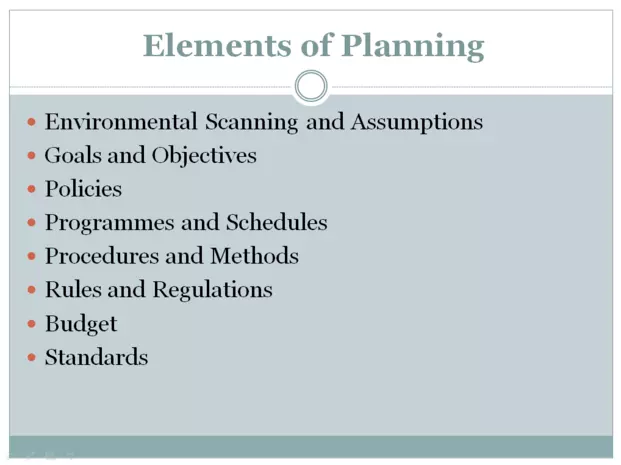Elements of Planning
The outcome of planning is an overall plan for the business. This plan contains different important components that must receive attention. Although the existence of these components in a plan does not guarantee success, it does lead to more comprehensive and orderly planning.
The various elements of planning are as follows:
- Environmental Scanning and Assumptions
- Goals and Objectives
- Policies
- Programmes and Schedules
- Procedures and Methods
- Rules and Regulations
- Budget
- Standards
1) Environmental Scanning and Assumptions
Environmental scanning is the organised method that management uses to study variables in the external environment and to anticipate trends and changes for strategic planning. This is done to identify opportunities and threats as essential inputs for planning.
The expected trends serve as primary planning premises or assumptions. These assumptions should be carefully monitored. Unforeseen events can alter the assumptions drastically. If that happens, plans that are based on assumptions have to change.
2) Goals and Objectives
The result that the business strives for must be spelt out as goals (long-term) and objectives (short-term). Webster’s Dictionary defines objectives as “that towards which effort is directed or end of action or goal”. Hence objectives or goals may be described as the ends towards which the group activities are aimed. All these aims form a hierarchy of goals that are implemented using the management-by-objectives process. This process results in a written of the goals and objectives at specific levels of management. Goals and objectives form parts of the different plans.
3) Policies
A policy is a general guideline for management when making decisions and sets the limits within which such decisions must be made when similar situations occur repeatedly.
Policies aim to facilitate decision making in the hierarchy and to ensure that there is unity of action and agreement in decision making, thus promoting coordination and integration. Top management will prepare business policies that can serve as guidelines for the functional policies of the lower levels of management. During the planning process management must ensure that all plans are in line with the policies of the company.
4) Programmes and Schedules
A programme gives an exposition of the activities and sequence in which activities must be performed to achieve a particular objective. The purpose must first be studied carefully to determine what activities are applicable. The main activities are arranged in order of importance. Each step should contribute to the achievement of the purpose. Programmes show the way and lay down procedures for activities to take place within a time limit for accomplishing the stated objectives. The constituents of a programme are objectives, procedures, policies, rules, methods and resources to be used for obtaining the objectives.
Scheduling determines the starting and finishing time for each activity. Scheduling can be done using network analysis, such as the Programme Evaluation and Review Technique (PERT).
5) Procedures and Methods
A procedure prescribes a fixed way of acting to deal with a task. They spell out the actions to be taken in practice to achieve the organisation’s objectives as stated in the policies. Procedures may be static or changed often. Organisations have set methods for procuring raw materials, recruiting personnel etc.
A method broadly indicates the action and technique that must be followed to complete certain activities. Methods are work plans, since they provide the method and order, keeping the objectives, time and facilities available. Methods involve only one department and one individual. They contribute to efficiency in working and help work planning & control. Methods are used in marketing, manufacturing, and office work.
6) Rules and Regulations
Rules and regulations are closely related to procedures because actions are specified and determined by them. Rules are different from procedures and policies. A rule requires a specific action to be taken or not taken concerning a case. Rules do not allow any discretion when it comes to the application of rules. Also, they do not allow any leniency to come in the route of their application.
Fixed instructions as to what may or may not be done are laid down. A rule may be part of a process or it can exist independently. An example of rules and regulations is that a worker must wear his safety helmet in the workplace at all times or that no supplies may leave the stores without an authorised requisition.
7) Budget
Every plan must be accompanied by a budget. This gives in financial terms the number of funds needed to execute the plan. A budget is a statement of expected financial outcomes. The expected outcomes can be expressed in man hours, product units or financial terms. The budgeting system serves as a means of control over the implementation of activities and the spending of funds.
8) Standards
A standard is a predetermined norm or criterion with which the performance must comply. A standard can be set in terms of the number of units that must be produced, the quality of a product, the cost per unit or the time taken to complete a task or activity.
During planning, measures must be set with which the actual performance can be compared. The measure serves as a target to be strived for.
Related Articles:
- nature of marketing
- difference between questionnaire and schedule
- features of marginal costing
- placement in hrm
- limitations of marginal costing
- nature of leadership
- difference between advertising and personal selling

You May Also Like:-
